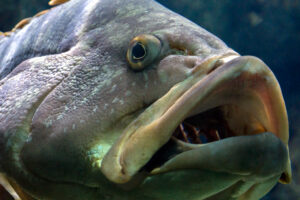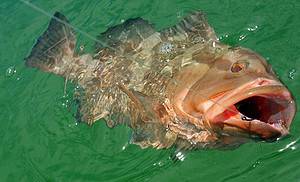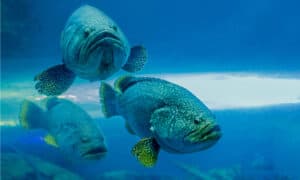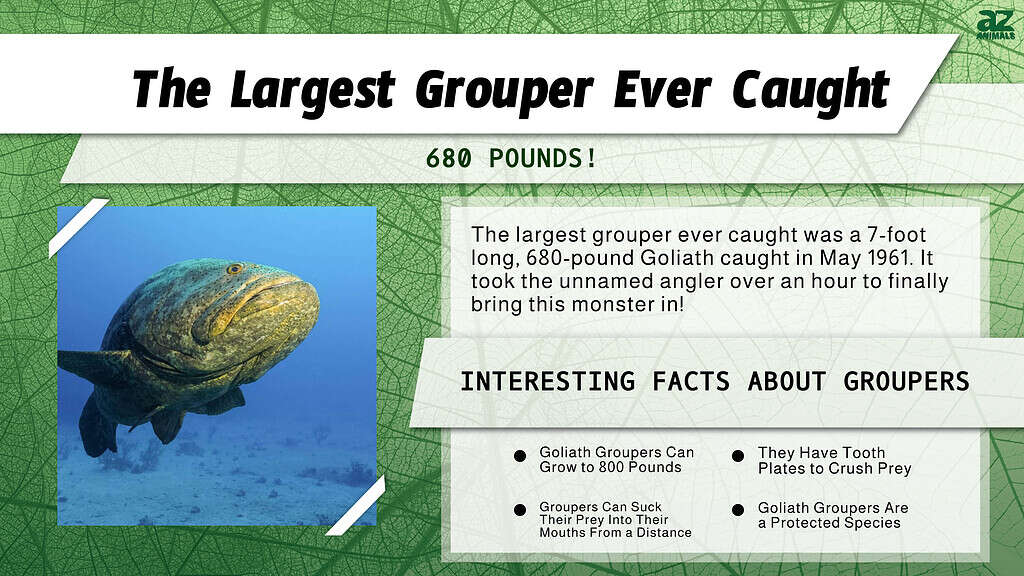
When people talk about going fishing, they aren’t always specific about the types of fish they would like to catch. Some would be happy to catch any fish at all, regardless of size, while some go specifically for larger fish, such as the largemouth bass.
However, anyone who wants a real fishing challenge should consider trying to catch a grouper. These fish can grow to be absolutely gargantuan, and catching one would take a great deal of skill, not to mention physical strength!
You might be wondering now, what kinds of groupers have people been able to catch? Read on to discover the largest grouper ever caught!
Background on the Grouper

Groupers are multiple genera of bony fish within the
Epinephelinaesubfamily, some of which can be extremely large.
©Barbara Ash/Shutterstock.com
Groupers are members of multiple genera within the subfamily Epinephelinae. The subfamily is part of the Serranidae family, which is part of the order Perciformes. Also, members of the Serranidae family are sea basses, but these are not groupers.
“Grouper” is a common name, most often bestowed upon fish that are members of two large genera: Epinephelus and Mycteroperca. Species within multiple small genera within the subfamily Epinephelinae are often referred to as groupers as well.
Grouper fish usually have stout bodies and large mouths. They are known to have the potential to be very large. They don’t have many teeth on the edges of their jaws, but they do have heavy tooth plates inside their pharynx that crush their prey.
Groupers typically eat animals such as octopuses, fishes, and crustaceans. Their mouth and gills create a very strong vacuum that can suck their prey in from a fair distance. Rather than biting pieces off of their prey, they swallow them.
What Is the Record for the Largest Grouper Ever Caught?
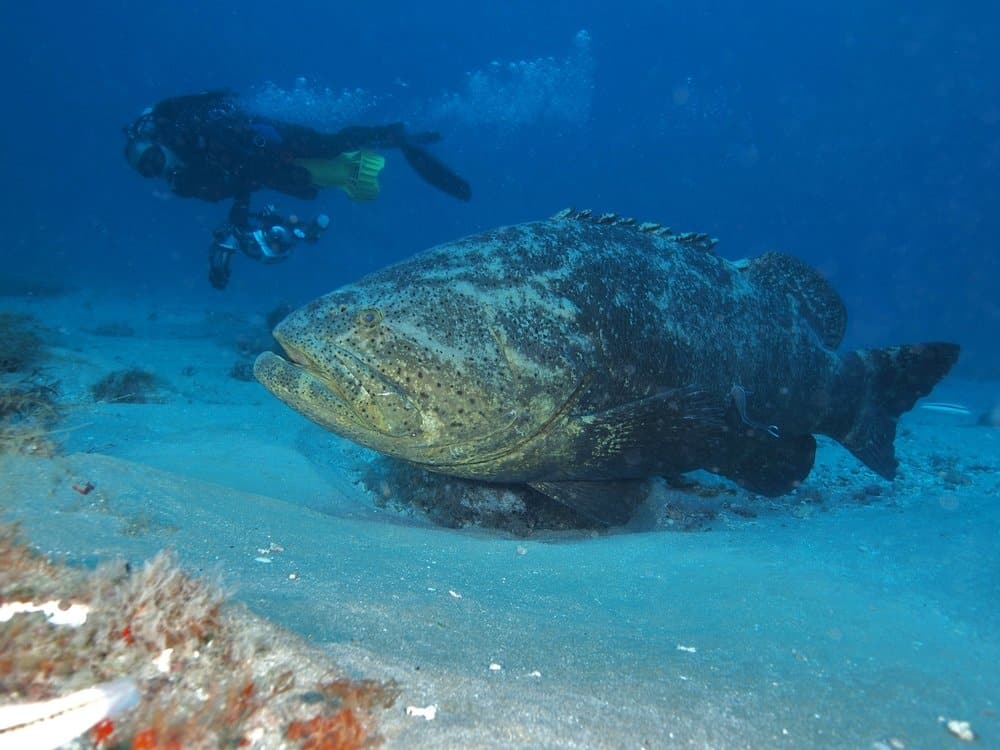
The largest grouper ever caught was a 680-pound, seven-foot-long Goliath grouper in May 1961.
©Jonathan Churchill/Shutterstock.com
The largest grouper ever caught, according to American Oceans, was a 680-pound fish caught in May 1961. The angler who caught this fish fought with the grouper for more than an hour in order to obtain it. The fish was also about seven feet long. In June 2021, another group of anglers caught a 500-pound grouper, but the original record has yet to be broken.
Theoretically, it is possible that this record could be beaten. There are Goliath groupers that have been documented to weigh about 800 pounds. If someone were to catch one of these, obviously, it would break the existing record.
However, one needs to keep in mind that due to their massive size and strength, these fish would be very difficult to catch, as was the record-breaking grouper.
The Goliath grouper is the largest grouper species by far. For many people, if they catch one of these, it will be the biggest fish they ever catch in their lifetime. The Goliath grouper is usually the largest of the bunch in certain environments, including reef locations and shallow waters.
However, if you’re interested in catching a Goliath grouper, you should know that it’s a protected species. You can catch them, but you can’t harvest them, no matter how large they are.
How Does the Record-Breaking Group Compare to Other Groupers?
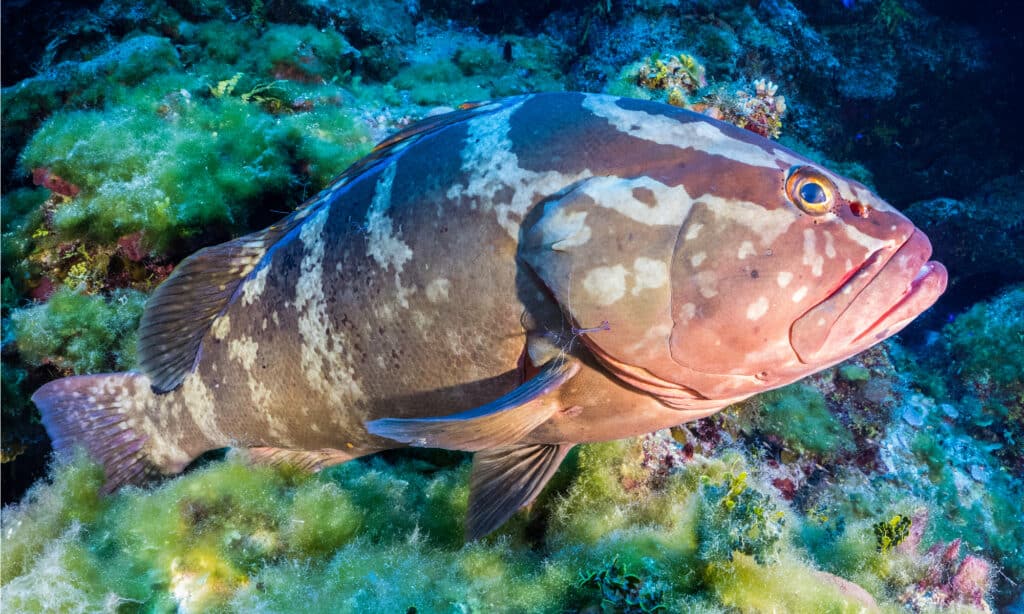
While many grouper species are large, they are typically much smaller than the Goliath grouper.
©Drew McArthur/Shutterstock.com
The record-breaking grouper was, again, a Goliath grouper. This is one of the largest grouper species, the largest in the Atlantic Ocean, and it can weigh up to 800 pounds. Groupers are typically large fish, but they are generally much smaller than this.
For example, the black grouper can weigh up to 180 pounds and will generally grow to be about five feet in length. This fish is found primarily either in the Caribbean Sea or the Gulf of Mexico/South Atlantic Ocean.
The Nassau grouper is even smaller. Found in locations such as Southern Coastal Florida, the Florida Keys, the Caribbean Sea, Bermuda, and the Yucatan, this fish generally grows to weigh a maximum of 55 pounds. Adults can be up to four feet in length.
Gag groupers are similar in size to the Nassau grouper, reaching about 50 pounds and three feet in length at the maximum. Gag groupers are typically found in the western Atlantic Ocean, as are red groupers, which grow to be almost 50 inches in length and a little bit over 50 pounds.
However, there are grouper fish species that can give the Goliath grouper a run for its money period. For example, the Queensland grouper, also known as the giant grouper, is the largest reef-dwelling bony fish on this planet. These groupers can grow to be about 880 pounds and eight feet long.
Queensland groupers are found throughout the Indo-Pacific and often find shelter in caves, within shipwrecks, and coral reefs. However, as no one has ever caught a grouper this large on record, the largest grouper ever caught remains a Goliath grouper for now.
What Are Some Great Places to Catch Groupers?
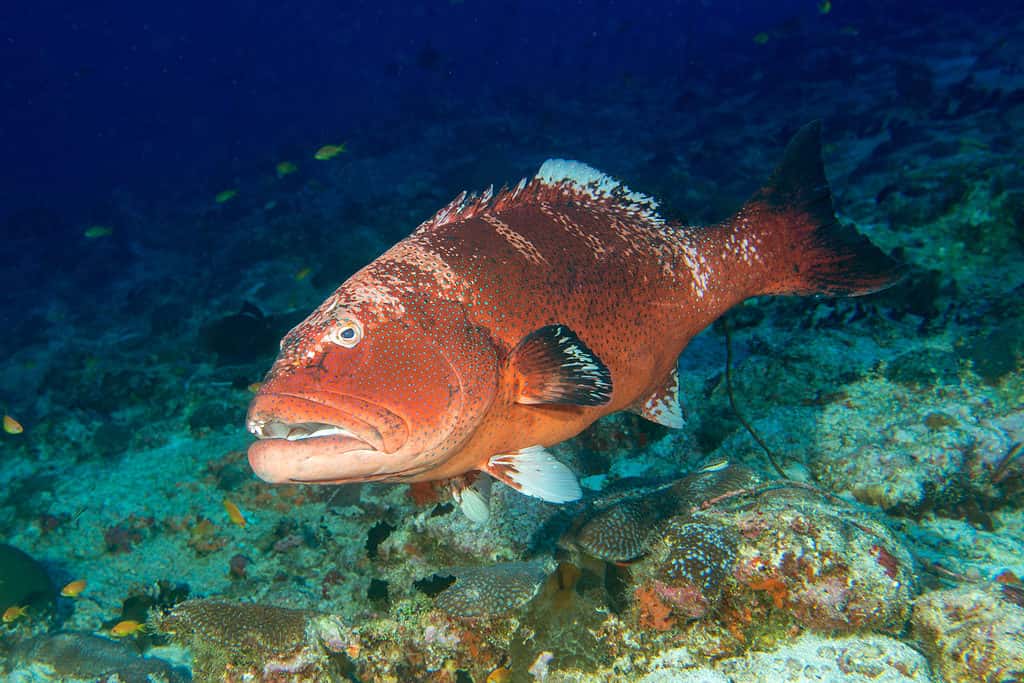
The giant Goliath grouper, the largest type of grouper, has the ability to reach a length of up to 8 feet and weigh more than 800 pounds.
©Andrea Izzotti/Shutterstock.com
Depending on the grouper species you are looking for, you can find them in many places. There are many grouper species around New England and the coastal waters of South America, as well as the coastline of Texas and the Gulf of Mexico. The most abundant population of groupers is known to reside around the Florida Keys.
If you’re trying to catch a grouper, it’s good to keep in mind that all grouper fish prefer to live near cover. It helps them hide from predators and efficiently hunt for their own prey. They use both natural structures, such as coral reefs, live bottoms, and bottom ledges, and man-made habitats, such as shipwrecks and artificial reefs.
Typically, if you want to hook a large grouper fish, it’s better to do so offshore than inshore. This is where they tend to find the structures that provide them with cover. They prefer ambushing their prey to chasing bait. This is why medium-heavy bottom fishing tackle is your best chance at getting the grouper to come to you.
Groupers tend to feed on other small fish, squid, and crustaceans, such as crawfish and crabs. These, then, will make the best bait to catch the grouper.
Of course, you do need to keep in mind that many grouper species are protected. This is why you need to make sure you are familiar with the law wherever you are fishing. You don’t want to illegally capture one of these protected fish.
The photo featured at the top of this post is © Samakai/Shutterstock.com
Thank you for reading! Have some feedback for us? Contact the AZ Animals editorial team.



